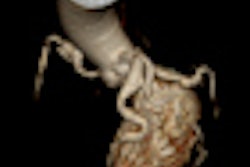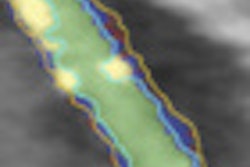
NEW YORK (Reuters Health), Jul 29 - Coronary calcium scoring can be used to predict future severe cardiac events in patients with stable coronary artery disease (CAD).
"Myocardial perfusion imaging with single photon emission computed tomography (SPECT) is generally accepted as a valuable tool for estimating patient risk and planning further clinical management of patients with stable coronary artery disease," Dr. Marcus Hacker, of the University of Munich, Germany, and colleagues write in the July 28 online issue of Radiology.
"Coronary artery calcification is a highly specific marker of coronary atherosclerosis, the extent of which is directly related to the atherosclerotic plaque burden," they add. "To the best of our knowledge, there have been no published reports that examine the complementary use of SPECT myocardial perfusion imaging and coronary artery calcification scores for risk stratification in patients with stable CAD."
The team evaluated the incremental prognostic value of adding coronary artery calcification (CAC) scores to SPECT myocardial perfusion imaging for predicting future cardiac events and long-term survival in 260 CAD patients followed for a median of 5.4 years for severe cardiac events (cardiac death or nonfatal myocardial infarction).
The participants underwent coronary artery calcification scanning and SPECT myocardial perfusion imaging between July 1997 and April 2006. Of the 260 patients, 178 (68.2%) were symptomatic.
The patients were stratified on the basis of well-established cutoff points for coronary artery calcification score, summed stress, the summed difference score, and the summed rest score.
The authors report that restS and SSS were significantly increased in patients with prior myocardial infarction (MI) (p < 0.001). Patients who were symptomatic had significantly increased ddd. A total of severe cardiac events, including 12 cardiac deaths and 11 MIs, were recorded. Overall, 40 (15.4%) coronary revascularizations were performed.
The only independent predictors of event-free survival were CAC and c. The risk of subsequent severe cardiac events was significantly higher among patients with perfusion abnormalities at rest or a CAC score greater than 400 compared to other patients (14.4% versus 4.7% and 13.2% versus 5.8%, respectively).
The risk was also increased among those with severe perfusion abnormalities under stress.
"In addition, a coronary artery calcification score of more than 400 offered incremental prognostic value over the scintigraphic scores alone," Dr. Hacker and colleagues explain. "When used in combination with an SRS of at least 2 or an SSS greater than 8, a higher CAC score (>400) helped identify those patients at highest risk for severe cardiac events."
Compared to patients without a known MI, those with a known MI had a significantly increased risk of severe cardiac events (p = 0.001) and coronary revascularization therapy (p = 0.01) during long-term follow-up. Symptomatic patients were also at significantly higher risk of severe cardiac events compared to those who were asymptomatic (p = 0.009).
Radiology 2009;253.
Last Updated: 2009-07-28 17:30:13 -0400 (Reuters Health)
Related Reading
Zero calcium means good outcomes, even with undetected plaques, July 23, 2009
Prospectively gated coronary CTA nearly equals normal-dose scans, July 17, 2009
Repeated calcium scans increase cancer risk, study finds, July 13, 2009
Obstructive coronary artery lesions possible without calcification, July 1, 2009
CTA predicts coronary plaque instability, June 30, 2009
Copyright © 2009 Reuters Limited. All rights reserved. Republication or redistribution of Reuters content, including by framing or similar means, is expressly prohibited without the prior written consent of Reuters. Reuters shall not be liable for any errors or delays in the content, or for any actions taken in reliance thereon. Reuters and the Reuters sphere logo are registered trademarks and trademarks of the Reuters group of companies around the world.



















